FIFY.How can you mention Alabama and not talk about her being the filming location of the documentary, "Under Siege?"
-
Please take a moment and update your account profile. If you have an updated account profile with basic information on why you are on Air Warriors it will help other people respond to your posts. How do you update your profile you ask?
Go here:
Edit Account Details and Profile
You are using an out of date browser. It may not display this or other websites correctly.
You should upgrade or use an alternative browser.
You should upgrade or use an alternative browser.
Ship Photo of the Day
- Thread starter Randy Daytona
- Start date
I'm too lazy to look far enough back, but have we discussed the USS Long Island? She was the first genuine "escort carrier" born from FDR's desire to get auto-gyros working ASW over the Atlantic convoys. Her hull was pulled from the Merchant Marine fleet and she was quickly decked over for carrier operations and called rated as AVG-1, later CVE-1. Cursed with an under-powered engine, she was soon eclipsed with better, newer "jeep" carriers but nonetheless saw some action in both the Atlantic and Pacific. After the war she was striken and picked up by a shipping line where she lost her flight deck for more traditional upper works and ended up staying around until 1977.
Among her highlights - she was the final training carrier for VT-8 before they deployed for their date with destiny at Midway. She escorted FDR across the Atlantic for two of his trips, and was the first carrier to deliver aircraft to Guadalcanal. She started life with a wing of SOC-3A Seagulls and F2A Buffalo's and ended it bring on F6 Hellcats (if only in a training role).
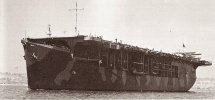
An unlucky Brewster Buffalo. Were they ever "lucky?"
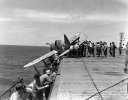
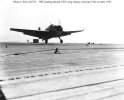
An interesting element of her design...her catapult ran diagonally across the deck...
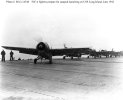
In "retirement."
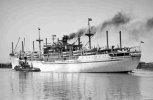
Among her highlights - she was the final training carrier for VT-8 before they deployed for their date with destiny at Midway. She escorted FDR across the Atlantic for two of his trips, and was the first carrier to deliver aircraft to Guadalcanal. She started life with a wing of SOC-3A Seagulls and F2A Buffalo's and ended it bring on F6 Hellcats (if only in a training role).

An unlucky Brewster Buffalo. Were they ever "lucky?"


An interesting element of her design...her catapult ran diagonally across the deck...

In "retirement."

Max the Mad Russian
Hands off Ukraine! Feet too
An unlucky Brewster Buffalo. Were they ever "lucky?"
Yeah, saddled by Finnish Air Force pilots (mostly NCOs, partly by Finnish Sweis). Think this is an outcome of two reasons: Soviet weakness (up to 1943 there were I-153 byplanes against them) and Finnish good materiel training (each pilot could change the engine and repair MGs with just little help of the infantry troops). Nevertheless, some Finnish Brewster drivers were able to kill Il-2 attack planes in between the dogfights with Soviet fighters. Their personal accounts for 50-60 kills were not unheard of.
Yeah, saddled by Finnish Air Force pilots (mostly NCOs, partly by Finnish Sweis). Think this is an outcome of two reasons: Soviet weakness (up to 1943 there were I-153 byplanes against them) and Finnish good materiel training (each pilot could change the engine and repair MGs with just little help of the infantry troops). Nevertheless, some Finnish Brewster drivers were able to kill Il-2 attack planes in between the dogfights with Soviet fighters. Their personal accounts for 50-60 kills were not unheard of.
The highest scoring Finnish ace Ilmari Juutilainen, who was also the highest scoring non-German ace, got 34 of his 94 confirmed kills in the Brewster Buffalo. Apparently there were a total of 36 Finns who made ace in the Buffalo.
Max the Mad Russian
Hands off Ukraine! Feet too
Capt Hans Wind, FAF, had apparently 39 kills in a Buffalo plus 36 more in Bf109G. And some Dutch Air Force pilots on the Far East had claimed up to 20 Jap airplanes altogether flying same B-239, an export version of Buffalo.
Max the Mad Russian
Hands off Ukraine! Feet too
Doubt Soviet Bell P-39/63 Cobra aces (top scored - 59 confirmed) were better pilots than those in RAF and USAAF who hated that aircraft. What mattered also was the average height of the dogfights and its using to an advantage, i.e. proper tactics. Tree-top fights over Soviet/German (Soviet-Finnish as well) lines allowed to get the best from such birds like Cobra and Buffalo. Where there were higher clashes - these fighters suffered...
I-19 was a Japanese B1 type submarine. On 15 Sep 1942, she sighted the aircraft carrier Wasp and fired a spread of 6 torpedos: 3 hit the Wasp near the gasoline storage tanks fatally wounding her, 2 passed astern which eventually sank the destroyer O'Brien and the last torpedo went under the Wasp and struck the battleship North Carolina in its most vulnerable spot (abeam the #1 turret), severely damaging the battleship and coming close to penetrating the dreadnought's armored magazine. Perhaps the most impressive torpedo spread in history. The I-19 was eventually sunk by the USS Radford on 25 November 1943 roughly 50 miles west of Makin Island.
Length: 357 ft, Beam: 31 ft, Displacement: 2,584 tons surfaced, 3,654 tons submerged
2 diesels developed 12,400 HP gave 23.5 knots on the surface, electric motors developed 2,000 HP and allowed 8 knots submerged.
Main armament: 6 x 533mm torpedo tubes, 1 x 140mm cannon
Commissioned: 28 April 1941 Sunk: 25 November 1943

Japanese submarine I-19

Nice model

Wasp on fire shortly after being torpedoed.

Torpedo from I-19 hits O’Brien. USS Wasp can be seen burning in the background.
Length: 357 ft, Beam: 31 ft, Displacement: 2,584 tons surfaced, 3,654 tons submerged
2 diesels developed 12,400 HP gave 23.5 knots on the surface, electric motors developed 2,000 HP and allowed 8 knots submerged.
Main armament: 6 x 533mm torpedo tubes, 1 x 140mm cannon
Commissioned: 28 April 1941 Sunk: 25 November 1943

Japanese submarine I-19

Nice model

Wasp on fire shortly after being torpedoed.

Torpedo from I-19 hits O’Brien. USS Wasp can be seen burning in the background.
BB-56, USS Washington. A North Carolina class battleship, she had the distinction of getting hit only once (a Japanese 5" shell went through her radar antenna but did not explode and never lost a man to the enemy). The Washington served both convoy duty in the Atlantic as a deterrent to the Tirpitz and then transferred to the Pacific fighting in many campaigns - the most famous being the night fight at the 2nd naval battle at Guadalcanal. The Washington, South Dakota and 4 destroyers faced a Japanese task force consisting of the battleship Kirishima, 2 heavy cruisers, 2 light cruisers and 9 destroyers. 3 of the 4 US destroyers were sunk and the South Dakota (suffering from a self inflicted electrical failure) severely damaged, but the "The Mighty W" steamed onwards and confronted the 14 vessels of the enemy fleet alone in the pitch black night. Identifying the Kirishima at less than 9,000 yards, the radar aided 16" cannons straddled the Japanese battleship on the first salvo, the 2nd salvo 30 seconds later scored a direct hit and the 3rd salvo was the motherload - 5 of the 9 shells impacted the Kirishima.
https://www.nationalww2museum.org/war/articles/second-naval-battle-guadalcanal
Length: 729', Beam: 108' Displacement: 45,000 tons at full load
121,000 HP gave 28 knots
Main armament: 9 (3x3) 16"/45 calibre Mark 6's, secondaries: 20 (10x2) 5"/38 calibre, multiple Bofors 40mm and Oerkilon 20mm
Armor: main belt: 12", Turret: 16"
Commissioned: 15 May 1941, Decommissioned: 27 June 1947, Struck: 01 June 1960

Washington fires upon Kirishima during the battle on 15 November. (Notice the low angle of the main guns as the Washington is firing at just over 8,000 yards - close to point blank range for a battleship.)

USS Washington anchored at the Puget Sound Navy Yard (Repairs after colliding with the battleship USS Indiana.)

Washington (BB-56) on 12 November, 1943 with unknown Essex class carrier, (Probably) Yorktown (CV-10) or Lexington (CV-16), steams towards the Gilbert Islands to take part in Operation Galvanic.

A very impressive and rare line of fast battleships during the Marianas Operation, June 1944. Battleships are from front to rear: Washington (BB-56),North Carolina(BB-55), South Dakota (BB-57). Others involved were Indiana (BB-58), Alabama (BB-60), Iowa (BB-61), and New Jersey (BB-62). Here the ships are conducting AA practice to port.

Four Battleships of Task Group 58.7 in the fleet anchorage at Majuro Atoll in the Marshall Islands. It was taken on the 7/8/44. TG 58.7 had returned to Majuro on 27 June 1944, after taking part in operations in the Phillipine Sea and bombarding Siapan and Tinian.
The four Battleships are identifiable by their paint schemes: New Jersey (BB-62) and Iowa (BB-61) in the foreground, and Washington (BB-56) and North Carolina(BB-55) further back, surrounded by destroyers and other ships

TG 38.3 enters Ulithi anchorage in column, 12 December 1944 while returning from strikes on targets in the Philippines. Ships are (from front): Langley (CVL-27);Ticonderoga (CV-14); Washington (BB-56); North Carolina (BB-55); South Dakota (BB-57); Santa Fe (CL-60); Biloxi (CL-80); Mobile (CL-63) and Oakland (CL-95).
https://www.nationalww2museum.org/war/articles/second-naval-battle-guadalcanal
Length: 729', Beam: 108' Displacement: 45,000 tons at full load
121,000 HP gave 28 knots
Main armament: 9 (3x3) 16"/45 calibre Mark 6's, secondaries: 20 (10x2) 5"/38 calibre, multiple Bofors 40mm and Oerkilon 20mm
Armor: main belt: 12", Turret: 16"
Commissioned: 15 May 1941, Decommissioned: 27 June 1947, Struck: 01 June 1960

Washington fires upon Kirishima during the battle on 15 November. (Notice the low angle of the main guns as the Washington is firing at just over 8,000 yards - close to point blank range for a battleship.)

USS Washington anchored at the Puget Sound Navy Yard (Repairs after colliding with the battleship USS Indiana.)

Washington (BB-56) on 12 November, 1943 with unknown Essex class carrier, (Probably) Yorktown (CV-10) or Lexington (CV-16), steams towards the Gilbert Islands to take part in Operation Galvanic.

A very impressive and rare line of fast battleships during the Marianas Operation, June 1944. Battleships are from front to rear: Washington (BB-56),North Carolina(BB-55), South Dakota (BB-57). Others involved were Indiana (BB-58), Alabama (BB-60), Iowa (BB-61), and New Jersey (BB-62). Here the ships are conducting AA practice to port.

Four Battleships of Task Group 58.7 in the fleet anchorage at Majuro Atoll in the Marshall Islands. It was taken on the 7/8/44. TG 58.7 had returned to Majuro on 27 June 1944, after taking part in operations in the Phillipine Sea and bombarding Siapan and Tinian.
The four Battleships are identifiable by their paint schemes: New Jersey (BB-62) and Iowa (BB-61) in the foreground, and Washington (BB-56) and North Carolina(BB-55) further back, surrounded by destroyers and other ships

TG 38.3 enters Ulithi anchorage in column, 12 December 1944 while returning from strikes on targets in the Philippines. Ships are (from front): Langley (CVL-27);Ticonderoga (CV-14); Washington (BB-56); North Carolina (BB-55); South Dakota (BB-57); Santa Fe (CL-60); Biloxi (CL-80); Mobile (CL-63) and Oakland (CL-95).
Last edited:
No, none of it has to be baked into the ship already but they would likely have to be significant modifications that cost a lot of money that may or may not pan out in the end. The SCB-27 modifications to the Essex-class to make them jet-compatible were significant and took two years in the shipyard at a significant cost mainly during the 50's when the DoD was swimming in money. Not only that but the shipyards had significant recent experience in working on carriers having spit out scores of them during WWII.
Modifications to handle V-22's and F-35's on US ships already equipped to handle jets and ~30 aircraft are relatively minor than refitting a ship to handle jets when it wasn't designed as such to start with.
I am not saying the ROKN or the JMSDF won't modify their ships to do operate the F-35 or even the Harrier but I think it'll take a lot more modification and money than folks realize, especially the online 'experts' who apparently can asses the aircraft compatibility of a ship just by looking at it, and that is after they make the step of deciding to do so in the first place which for the Japanese especially would be a significant geopolitical decision. Just ask the Brits about their carriers and how much time, political wrangling and money they have taken up so far.
Perhaps this answers the intent of the Japanese Navy.
Some 40 of the order would be F-35Bs, capable of short take offs and vertical landings on a warship, confirmed the source.
Adding credence to the report, Japanese Defense Minister Takeshi Iwaya said Wednesday that Tokyo is seriously considering refitting at least one of its Izumo helicopter destroyers to accommodate jets, essentially transforming one or both of the 27,000-ton vessels into aircraft carriers.
....a refitted Japanese carrier would likely only carry six to eight F-35Bs, compared to as many as two dozen jets that will be on Chinese carriers now in sea trials or production.
https://www.cnn.com/2018/11/29/asia/japan-f-35-fighter-aircraft-carrier-intl/index.html

The Japan Maritime Self-Defense Force ship JS Izumo sails the South China Sea with the US guided-missile destroyer USS Dewey.
...Japanese Defense Minister Takeshi Iwaya said Wednesday that Tokyo is seriously considering refitting at least one of its Izumo helicopter destroyers to accommodate jets....a refitted Japanese carrier would likely only carry six to eight F-35Bs, compared to as many as two dozen jets that will be on Chinese carriers now in sea trials or production.
Given the cost and time needed to upgrade one of their ships I am not sure the juice is worth the squeeze militarily for a mere 6-8 jets, and the decision would be a primarily political one. It would be smarter to buy the F-35B's and utilize them like the RAF practiced using their Harriers and the Swedes used Viggens in the 70's and 80's, as combat aircraft capable of operating from austere and non-standard locations during a conflict.
Given the cost and time needed to upgrade one of their ships I am not sure the juice is worth the squeeze militarily for a mere 6-8 jets, and the decision would be a primarily political one.
While it may not bring much capability as a stand-alone, they could stand as a pretty lethal add-on in a CVN strike force construct.
Given the cost and time needed to upgrade one of their ships I am not sure the juice is worth the squeeze militarily for a mere 6-8 jets, and the decision would be a primarily political one. It would be smarter to buy the F-35B's and utilize them like the RAF practiced using their Harriers and the Swedes used Viggens in the 70's and 80's, as combat aircraft capable of operating from austere and non-standard locations during a conflict.
With 40 jets, why not both?
Max the Mad Russian
Hands off Ukraine! Feet too
Well, when the last HMS Ark Royal lost her Sea Harriers FA2 it turned out that all that remained, namely RAF Harrier GR.7/9 had the nav and comm system incompatible to the ship's ones so they had to spend several million pounds just to fix it by installing the new equipment on the ship.

